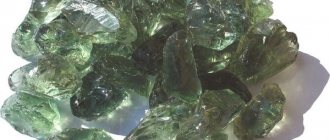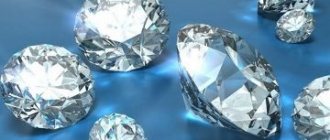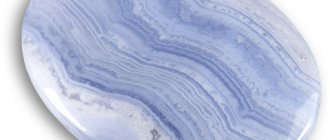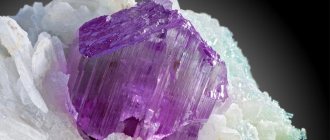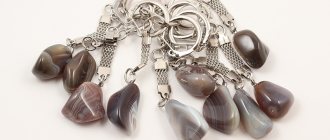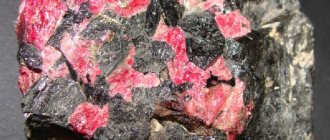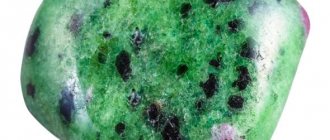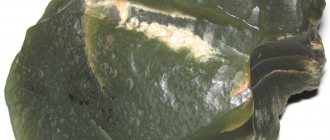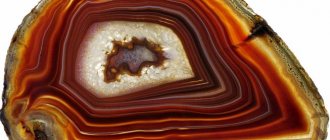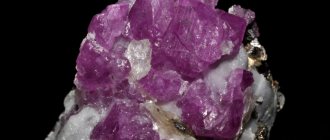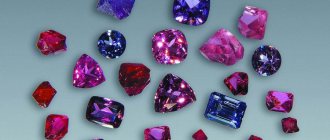Chiastolite is a mysterious mineral that is surrounded by true stories and legends, scientific sensations and sacred rituals. Even the process of stone formation remains a mystery; there are only assumptions.
For thousands of years, the mineral was used in many cultures as a talisman, and until the end of the 16th century it embodied devotion to God for pilgrims of the Way of St. James.
Story
The name of the stone is translated from Greek as “cross”: “hias” means “cross”.
The ancient peoples knew about it:
- The indigenous people of America created the legendary history of chiastolite. The Araucan Indians turned the “stone with a cross” into an amulet against dark forces. During the Spanish Conquest, a cross on a stone embodied the souls of local soldiers who died in the fight against the invaders.
- The warlike Celts saw in it the focus of a force similar to a lightning strike.
The finest hour of the chiastolite struck with the beginning of the era of Christianity. The first adherents of the new faith made it their amulet.
The stone was discovered in Andalusia in 1754, near the pilgrim route of the Way of St. James of Campostela. This is the patron saint of wanderers, so they began to wear chiastolite as a talisman.
Who is the stone suitable for?
It is recommended to purchase chiastolite for those who have experienced stagnation in their lives. The talisman will help relieve tension and fatigue, both on the physical and spiritual levels.
Chiastolite can relieve tension and fatigue
The stone will be especially useful for women. It will increase their libido, and in nursing mothers it will help increase breast milk. If there is disagreement in the house, the cross will help bring harmony to the family and relationships.
Description
The mineral is an opaque, rather fragile agglomerate of a warm color with a glassy luster.
Typical colors of chiastolite are red-brown, gray, yellowish-brown. Less common are white, greenish, pinkish specimens.
The sign by which chiastolite is identified is dark intersecting lines. It looks like a cross, which appears more clearly in the cut.
Other names for the stone are maltesite, crucite, and cross stone.
In medieval lapidariums (books on minerals) it is referred to as lapis crucifer (crucifix stone).
How to distinguish a natural chiastolite stone from a fake one?
It is quite difficult to distinguish between the original and the copy. Chiastolite is often mistaken for tourmaline, smoky quartz and chrysoberyl. The design of the cross represents the main difference. It is incredibly difficult to artificially create an internal arrangement of stripes.
Before purchasing, you need to twist the chiastolite. You need to make sure that the cross does not disappear when rotated. The mineral is rarely used to create jewelry. As a rule, it is used by clergy and believers. It is usually combined with black stones. They double each other's properties.
Origin
The origin of the mineral is metamorphic, it is formed in carbonaceous or clayey rocks:
- The “cross” is formed when andalusite crystals grow together.
- During the growth of the crystal, inclusions of these rocks are shifted and flattened until they are compressed.
- If the graphite-clay component predominates, triangles appear at the ends of the cross. They make the cross similar to the Maltese one.
The stone has been known since pre-Christian times (that is, more than two thousand years). But it was scientifically described by the German scientist Dietrich Karsten only in 1800.
Causes of kidney stones (and what to do about it)
Nephrolithiasis ( renal stones or, less correctly, urolithiasis
) has haunted humanity since ancient times. At least Egyptian mummies already had kidney stones, and the Hippocratic Oath mentions treatment: “I will not take up a knife, even if truly confirmed, to treat someone suffering from kidney stones, but I will concede this [right] to those who are experienced.” in their removal."
Who gets kidney stones and why?
The risk of developing kidney stones for US adults is approximately 9%, and it is likely that global warming may increase this likelihood (as the climate gets hotter, a person's risk of dehydration increases, which in turn increases the likelihood of developing stones). Currently, four types of kidney stones are known: they can be formed on the basis of calcium oxalate or phosphate, uric acid salts, struvite (a combination of magnesium, ammonium and calcium phosphates) and cystine.
The main risk factor for all stones, regardless of their chemical composition, is dehydration. Any person who is aware of a predisposition to nephrolithiasis should pay special attention to fluid intake. A randomized clinical trial found that drinking at least two liters of fluid per day reduced the likelihood of recurrent kidney stones by about half. Guidelines for the treatment of nephrolithiasis published by the American Urological Association recommend that patients with a proven tendency to develop kidney stones drink more than 2.5 liters of water daily.
Anyone with symptoms of nephrolithiasis should see a urologist. The gold standard for initial diagnosis includes blood and urine tests, as well as one of the imaging studies. The decision about which specific diagnostic method should be used and which therapeutic strategy to choose should be made jointly by the doctor and the patient. Let's look at some risk factors and treatment prospects for the main types of kidney stones.
Calcium oxalate and calcium phosphate stones
Calculi (stones), consisting primarily of calcium salts, are the most common type of kidney stones; in turn, they can be calcium oxalate or calcium phosphate ( oxalate is a salt of oxalic acid, phosphate is a salt of meta-, ortho- or other phosphoric acid
). As shown above, adequate hydration is very important in preventing kidney stones. However, randomized studies have provided reliable data that may seem paradoxical: people with a tendency to calcium stone formation should not reduce the amount of calcium in their diet. The recommended daily allowance for calcium is 1,000 mg/day for women under 50 years of age and men under 70 years of age, and 1,200 mg/day for women over 50 years of age and men over 70 years of age. Why? Calcium binds to oxalate in the intestine and prevents its absorption through the intestinal wall; Consequently, less calcium and oxalate remain in the urine for stone formation or growth. Ideally, calcium should come from food. Consult your physician before taking any calcium supplements; Increasing your fluid intake should also be helpful, depending on how much calcium you take in daily.
Foods high in oxalates (nuts, spinach, potatoes, tea, chocolate, etc.) can increase the concentration of oxalates in the urine. Follow a sense of proportion.
Stones with a predominance of phosphates in the chemical composition are less common than calcium oxalate stones. The main causes of the formation of phosphate-type stones include hyperparathyroidism (increased secretion of parathyroid hormones), renal tubular acidosis (kidney pathology leading to a general “acidification” of the body) and urinary tract infections. It is important to establish whether one of these reasons lies behind the beginning of the growth of calcium phosphate stones in the kidneys.
Adequate hydration can be a good preventive measure against calcium stones. In addition, thiazide diuretics (diuretics) can promote calcium absorption by the kidneys, one of the effects of which is to reduce excess calcium for stone formation. Another remedy can be potassium citrate, which can bind calcium and thereby prevent the development of calcium oxalate and calcium phosphate urolithiasis.
Stones based on uric acid salts
Most patients with urate stones do not actually show elevated levels of uric acid in, say, the blood or other tissues. However, their urine is too acidic. If this occurs, normal concentrations of uric acid may dissolve in the urine and lead to crystallization, resulting in stone formation. Normalizing the pH of urine, most often achieved by administering potassium citrate, reduces the risk of the formation of urate kidney stones, and also promotes the dissolution of stones that have already formed. Sodium bicarbonate (more commonly known as baking soda) can also be used to leach urine. However, some patients with urate kidney stones do have elevated uric acid levels. For such patients, it is recommended to reduce animal protein intake; a medicine called allopurinol may also be indicated.
Struvite stones
Struvite stones consist mainly of magnesium and ammonium phosphates; they are formed from urine when the pH shifts to the alkaline side. The most common cause of struvite stone formation is a bacterial infection that increases the urine pH from normal acidic to neutral or alkaline. Acetohydroxamic acid (AHA) can lower urine pH and ammonia levels, which may help dissolve stones.
Cystine stones (the rarest type)
Cystinuria is a genetic, inherited metabolic disorder. It is manifested by an increased concentration of one of the amino acids (cystine) in the urine, which leads to the formation of stones from its salts. In most cases, cystine stones can be dissolved by increased hydration and medications that change the pH level of the urine. If this is not sufficient to bring the pathological tendency under therapeutic control, additional medications may be prescribed
Instead of a conclusion
All patients suffering from kidney stones should remember the key phrase: “Dilution is the solution to the pollution” ( a pun-rhyming play on words in English: “Dilution is the solution to the pollution”, where “solution”, depending on the context, can mean "solution" and "solution"
). Adequate fluid intake is a safe and effective therapy for any type of stone formation. However, consultation with a urologist is absolutely necessary, during which optimal approaches to examination, treatment and prevention of the formation of new kidney stones are developed.
Links:
Prevalence of Kidney Stones in the United States. European Urology, July 2012.
Climate-related increase in the prevalence of urolithiasis in the United States. Proceedings of the National Academy of Sciences, July 2008.
Urinary volume, water and recurrences in idiopathic calcium nephrolithiasis: a 5-year randomized prospective study. The Journal of Urology, March 1996.
Medical Management of Kidney Stones: AUA Guideline. American Urological Association, August 2014.
Meta-analysis of randomized trials for medical prevention of calcium oxalate nephrolithiasis. Journal of Endourology, November 1999.
Management of cystinuria. The Urologic Clinics of North America, August 2007.
Additional Information
Paid source: “ What to do with kidney stones
»
Physico-chemical characteristics
According to the chemical classification, the mineral chiastolite is an aluminum silicate. Its formula and composition are similar to andalusite. This is natural, since chiastolite is a type of this stone.
| Formula | Al2SiO5 |
| Color | Whitish-gray, grayish-yellow, brown, gray, pinkish-gray, bluish-gray, yellow, green |
| Stroke color | White |
| Shine | Glass |
| Transparency | Opaque, translucent |
| Hardness | 6,5 |
| Cleavage | Imperfect |
| Kink | Uneven |
| Density | 3.12 - 3.18 g/cm³ |
| singonia | Rhombic |
| Refractive index | 1,641 — 1,648 |
Inclusions reduce the strength of chiastolite.
Place of Birth
Chiastolite deposits are scattered across all continents. The raw material standards are different:
- Spanish stones from Andalusia are pleochroic and fluoresce.
- In Italy, red-brown, pink, light gray stones with a greenish tint are mined.
- Australia is saturating the market with howdenite. These are twin crystals, named after the place of extraction (the foot of Mount Howden). They are small, up to 4 cm, but with a pattern in the form of imprints of fern leaves.
- In the American state of Massachusetts, yellow, brown, brownish-red stones with a diagonal (as in St. Andrew's flag) cross are found.
- Russian deposits are concentrated in the Urals (Ilmen Mountains) and Transbaikalia. The former are famous for large samples (up to 10-11 cm), while red and brownish samples are extracted from the latter.
Significant production is carried out by Spain, China, Canada, Germany, Brazil, and France. The stone is found in Chile, Algeria, Myanmar, and Sri Lanka.
Areas of use
Chiastolite is most in demand in the jewelry industry. Unique products emerge from the hands of a skilled craftsman:
- beads;
- pendants;
- rings;
- brooches
Usually the stone is inlaid into simple metals so that the setting does not overshadow the natural beauty of the mineral. The cross piece looks most impressive in the form of cabochons or flat inserts.
Thus, the cross on the surface of the stone is more clearly visible. Rosary beads are made from samples of light shades. All products made using chiastolite will not only complement the image, but will also become a talisman against enemies.
Where is the stone used?
The area of application of the mineral determined its appearance. Since the first centuries of Christianity, stone has become the material for rosaries, icons, crosses, and other religious objects:
- The significance of the stone was realized by the participants of the Crusades to the east beyond the Holy Sepulcher. Everyone had a body amulet.
- Masonic attribute - chiastolite with a Maltese cross in a ring.
- The mineral is polished into a cabochon or round beads are machined. They are used to make rosaries and pendants. The frame is almost always the simplest, in the spirit of Christian ethics.
- Particularly high-quality specimens are faceted - these are inserts for rings.
Products from Chiastolite
In secular jewelry, bright gems are used, framed in white gold or silver. When buying jewelry with chiastolite, you need to be prepared for increased attention from others.
- A popular interior item is a stone ball on a stand.
Collectors hunt for white stones with a clear black cross.
Colors and shades of stone
Chiastolite has many colors and shades. The most common is brown with a dark pattern. The following shades of the mineral are also often found:
- white;
- grey;
- yellow;
- orange;
- green;
- red
All colors are in demand among jewelers and are suitable for making jewelry. You can also see a rare golden-colored gem. Whatever the main shade of the chiastolite, the cross against its background will always be black.
An amazing property of chiastolite is its ability to change color under different lighting conditions. This is called pleochroism.
How to care
The mineral is fragile, but it is easy to care for:
- Chiastolite must not be dropped or manipulated mechanically.
- Dirt is washed off with running water at room temperature. Can be used with baby or other neutral soap.
- The darkened chiastolite is left in water overnight along with the hematite.
- To preserve the color of the stone, the product is protected from harsh sun.
Chiastolite is immune to energy dirt, but it needs recharging.
The mineral is recharged by exposing it to the light of the full moon. If there is a suspicion of a magical attack or attack, you can cleanse it on the new moon.
Rules of care
It is necessary to take care of chiastolite regularly. The gem attracts all negative energy. That is why it is recommended to rinse it regularly under running water (it would be better to use spring water).
The liquid pressure should be small. It is important that the jet does not hit the stone. Afterwards you need to lay it on a soft cloth and wait until it dries completely, putting it in a dark place. After cleansing, chiastolite can be used again.
Chiastolite is a unique stone that has a dark cross on a light background. In history, many legends, superstitions, and predictions are associated with the mineral. It was valued and used by the Indians and Celts in Europe. To this day, people believe in the unique healing and magical properties of chiastolite.
Price
Russian online stores offer to buy collectible material and jewelry made of chiastolite at an affordable price (RUB):
- tumbling (China 1.5-2 cm) – 330 – 380;
- ball (33-36 mm) – 1,130 – 5,100;
- bracelet – 1,500 – 2,600;
- bead – 120-190;
- pendant (silver) – 2,900 – 3,400;
- ring (silver) – 3,100 – 3,800.
Chiastolite bracelet
This is the price of handmade products, there is no mass production.
Jewelry with mineral
To emphasize the originality of the crusader, the mineral is cut into flat oval plates or processed into cabochons. Jewelry with stones (earrings, pendants, rings), usually in a simple frame made of silver or white gold. Beads are used to create bracelets, rosaries, and necklaces.
The cost of jewelry is influenced by the place of origin of the stone and its size. The price of handicraft creations, unique in their kind, is, of course, always high.
- A pendant measuring 20 x 30 x 10 mm, without frame, costs approximately 1,300 rubles.
- A ring in an alloy frame with brass plating can be purchased for RUR 1,500.
- Bracelet made of chiastolite beads, 8–12 mm, – 9,500 rub.
- Beads, 4–20 mm, connected by copper, 100 cm long, – 18,000 RUR.
- Necklace size 50 cm, with handmade beads, with inserts of onyx, pyrite and silver – RUB 25,000.
Also read: Uvarovite - the emerald beauty of the Urals
Magic properties
External data predetermined the perception of the stone as a focus of mystical power.
Since ancient times, people have used the magic of chiastolite in rituals to drive out evil spirits. For sorcerers, it was a tool for communicating with other worlds and “reading” the past. They placed a stone in the area of the “third eye” or gazed at the pattern.
Esotericists have identified additional magical properties of chiastolite:
- It helps you concentrate and relieves you of guilt. This is used by monks and ordinary believers during prayer.
- This is the strongest home amulet against negative influences (natural elements, envy, damage, gossip).
- Particularly suitable for people associated with secret information, ordinary or sacred.
- It will help a creative person to believe in himself.
Its main meaning for a person is to remind him of his connection with God, to remember his love and forgiveness.
Compatibility with names and zodiac signs
Any zodiac sign according to the horoscope can use the stone, but it must be remembered that it tolerates a frivolous attitude. The astrological properties of chiastolite are that it helps a person whose intentions are pure and who wants to know universal wisdom for the benefit of other people.
(“++” – the stone fits perfectly, “+” – can be worn, “-” – is strictly contraindicated):
| Zodiac sign | Compatibility |
| Aries | + |
| Taurus | ++ |
| Twins | ++ |
| Cancer | + |
| a lion | + |
| Virgo | + |
| Scales | ++ |
| Scorpion | + |
| Sagittarius | + |
| Capricorn | + |
| Aquarius | + |
| Fish | + |
Chiastolite is especially favorable to Libra, who has a developed instinct and the ability to create harmony, enhancing these natural personality traits.
An opaque stone, which belongs to the element of Earth, will bring great benefits to Taurus. Will help solve problems by strengthening his analytical abilities.
The gem matches people like:
- Zoya.
- Yana.
- Ella.
- Karina.
- Tatiana.
Therapeutic effect
Lithotherapists have studied the healing properties of chiastolite:
- Stops bleeding, improves heart function.
- Treats skin from burns, wounds, rashes, scabs, smoothes scars.
- Helps remove waste and toxins.
- Cures colds, bronchitis, pneumonia.
- Powerful antioxidant: normalizes metabolism, improves the absorption of nutrients.
- Beneficial for joints: treats gout, rheumatism, restores mobility to the limbs.
- Enhances lactation in nursing mothers.
Along with physical ones, chiastolite heals mental wounds: depression, despondency, nervous disorders. This is especially useful for children and adolescents.
Constantly wearing jewelry with chiastolite changes a person’s mood: problems do not seem insoluble.
The healing properties of chiastolite stone
Chiastolite is endowed with numerous beneficial qualities. In ancient times, people paid attention to its versatility in the treatment of various diseases. It has a positive effect on health. The mineral has the power to defeat any disease. Information about the effectiveness and healing properties of chiastolite is contained in the books of healers and folk recipes. It normalizes the activity of the whole body. Thanks to the stone, beneficial substances are well absorbed. And it removes oxidants and harmful microelements.
